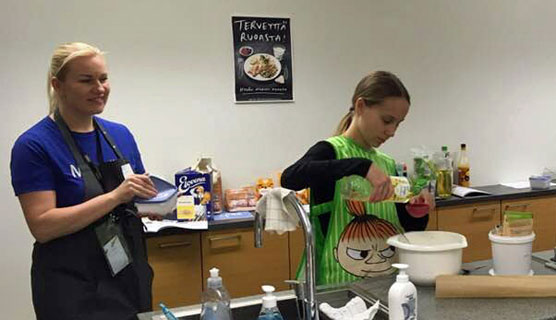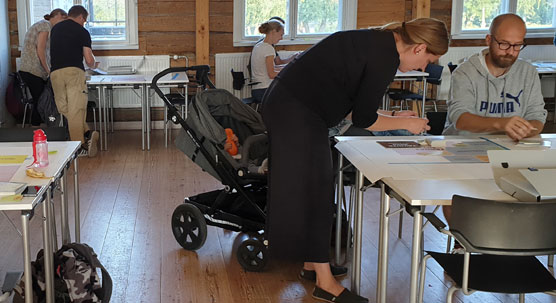
Cooking class with the Martha Organization. © Terhi Jantunen
The City of Lappeenranta has launched Greenreality home activities, which encourage households to move towards a more sustainable lifestyle. The activities are based on smart resource use and carbon neutrality.
Greenreality home activities involve collaboration between schools and homes. Some of the homes participating in the voluntary activities are doing so independently. The city offers them support through the Greenreality site and a newsletter. The city also offered households the opportunity to participate in a trial of sustainable everyday life.
The households involved obtained a great deal of information about the impacts of sustainable choices
During the one-month trial, households received guidance and hints for planning their daily activities in a new way to reduce their carbon footprint. They also got to test products and services that promote a sustainable lifestyle.
“Before the kick-off workshop, households completed a questionnaire on housing, transport, eating, household goods, holidays and leisure time. The answers were used to calculate the carbon footprint of each household. At the kick-off workshop, the households drew up a road map up to 2030 for reducing their carbon footprint. The households then chose ideas from the road map which they wanted to test during the trial period as well as ideas they wished to test over a longer period of time,” explains Sanna Laukkanen, expert in Greenreality services of the City of Lappeenranta.

Greenreality workshop. © Sanna Laukkanen
At the end of the trial, the households reported their success in carrying out the planned measures. Then, their carbon footprints were recalculated. At the final workshop, the participants discussed their results and experiences of the trial period and brainstormed for ways to promote sustainable lifestyles for households in the future.
The trial attracted many different types and sizes of households, including both single-person households and large families, working-age people and retirees. Many of the participants were already aware of climate change issues, and their carbon footprint was lower than the Finnish average. On the other hand, some of the families had a carbon footprint clearly higher than average.
The average carbon footprint of Finns is 10.3 tonnes of CO2 per person per year. It is high in international comparison. In the road map, each household was given the target of 2.5 tonnes of CO2 per person per year, to be achieved by 2030. On average, the households reduced their carbon footprint by 11 per cent (at an annual level) during the trial period. This meant that their average carbon footprint dropped from 6.3 tonnes to 5.6 tonnes of CO2 per person per year during the trial.
Collaborative efforts facilitate lifestyle changes
“It’s better to take action than suffer from climate anxiety,” says Laukkanen. She noticed during the trial how important it was for people to work together. The spirit of community was boosted at workshops, at vegetarian cooking courses arranged by the Martha Organization, a home economics organisation, and in the Facebook group set up for the trial.
Sanna Laukkanen believes that the trial period resulted in permanent changes. “The atmosphere at the final workshop led me to believe that many households will continue along the new path. The participants said that it would be easy to stick to the small daily actions they had learned during the trial, including changes in eating habits, giving up unnecessary things, using public transport and cycling. Many of the participants began to consider actions in the long run, such as replacing traditional cars with electric cars and reducing air travel.”
The Holtari family’s sustainable actions before and after the trial period
The Holtari family found the trial a positive experience. In their opinion, it could have lasted longer. The family would be glad to immediately participate in another similar project.
“We got involved because we wanted information based on facts and a supportive atmosphere,” says Paula Holtari, the mother of the family. The Holtaris had felt uncertain about whether they were doing things right.
“It was a good feeling, knowing that you could contribute to promoting sustainability,” says Jami Holtari, the father.
The Holtari family comprises two adults and one child. They live in a stone house built in the 1950s, which was renovated a few years ago. In connection with this, the oil heating system was replaced by geothermal heating.

The Holtari family. © Satu Tähkö
According to the initial calculations, housing and travel were the family’s main sources of emissions. The trial period coincided with a busy time, but the family nevertheless managed to carry out a few small changes. “These are aspects that we can improve in the long run,” says Jami, adding that they have, for example, reduced housing emissions by lowering the room temperature.
The family now has a multi-compartment rubbish bin in their yard, which has made waste sorting and recycling very easy. The bin is emptied once a month, but the compartments for cardboard and plastic sometimes fill up sooner than that. The family generates hardly any mixed waste any more.
“One of the most valuable insights was that you have to stop to think about these questions. Many of them had crossed our minds, but since we hadn’t taken the time to consider them in any greater detail, we also failed to take any action,” says Paula.
Aiming to make actions permanent
Eight-graders in Lappeenranta will now also learn to examine the carbon footprint of their own homes through Junior University. This will help to annually reach the homes of all those belonging to this age group. Plans are to continue the activities with new volunteering households.
Junior University is a training path that has been jointly created by LUT University and the City of Lappeenranta. “Junior University offers sustainability themes for all the age groups participating in it. In connection with our project, we have put together a study unit for eight-graders that focuses on clean energy and sustainable housing. Together with their parents, the pupils carry out an assignment that involves examining the carbon footprint of their home and considering ways to reduce it. In this way, pupils introduce ideas about sustainable life and housing to their families,” says Laukkanen.
Many different companies are also involved in the project. Corporate cooperation is carried out with companies belonging to the Greenreality Network, which focuses on the energy and environmental sector in South Karelia, as well as with other companies that offer products and services to support sustainable daily life.
The Greenreality trial for households is also part of the international Sustainable Lifestyles Accelerator, running in seven countries. The participating cities in Finland include Lappeenranta, Porvoo Vantaa, Kuopio, Valkeakoski, Lahti, Kauniainen, Helsinki and Joensuu. The Greenreality project for households and companies is coordinated by the City of Lappeenranta and LUT University and its main funding comes from the European Regional Development Fund.
More information
- Greenreality expert Sanna Laukkanen, City of Lappeenranta, tel. +358 50 532 6187, firstname.lastname@lappeenranta.fi
-
www.greenreality.fi/en